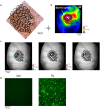Abnormal Population Responses in the Somatosensory Cortex of Alzheimer's Disease Model Mice
- PMID: 27079783
- PMCID: PMC4832196
- DOI: 10.1038/srep24560
Abnormal Population Responses in the Somatosensory Cortex of Alzheimer's Disease Model Mice
Abstract
Alzheimer's disease (AD) is the most common form of dementia. One of the neuropathological hallmarks of AD is the accumulation of amyloid-β plaques. Overexpression of human amyloid precursor protein in transgenic mice induces hippocampal and neocortical amyloid-β accumulation and plaque deposition that increases with age. The impact of these effects on neuronal population responses and network activity in sensory cortex is not well understood. We used Voltage Sensitive Dye Imaging, to investigate at high spatial and temporal resolution, the sensory evoked population responses in the barrel cortex of aged transgenic (Tg) mice and of age-matched non-transgenic littermate controls (Ctrl) mice. We found that a whisker deflection evoked abnormal sensory responses in the barrel cortex of Tg mice. The response amplitude and the spatial spread of the cortical responses were significantly larger in Tg than in Ctrl mice. At the network level, spontaneous activity was less synchronized over cortical space than in Ctrl mice, however synchronization during evoked responses induced by whisker deflection did not differ between the two groups. Thus, the presence of elevated Aβ and plaques may alter population responses and disrupts neural synchronization in large-scale networks, leading to abnormalities in sensory processing.
Figures




Similar articles
-
Amyloid Deposition and Dendritic Complexity of Corticocortical Projection Cells in Five Familial Alzheimer's Disease Mouse.Neuroscience. 2023 Feb 21;512:85-98. doi: 10.1016/j.neuroscience.2022.12.013. Epub 2022 Dec 19. Neuroscience. 2023. PMID: 36549605 Free PMC article.
-
Amyloid-β disrupts ongoing spontaneous activity in sensory cortex.Brain Struct Funct. 2016 Mar;221(2):1173-88. doi: 10.1007/s00429-014-0963-x. Epub 2014 Dec 19. Brain Struct Funct. 2016. PMID: 25523106
-
Acetylcholinesterase inhibitors ameliorate behavioral deficits in the Tg2576 mouse model of Alzheimer's disease.Psychopharmacology (Berl). 2005 Aug;181(1):145-52. doi: 10.1007/s00213-005-2230-6. Epub 2005 Oct 15. Psychopharmacology (Berl). 2005. PMID: 15778881 Free PMC article.
-
Amyloid plaque-independent deficit of early postnatal visual cortical plasticity in the 5XFAD transgenic model of Alzheimer's disease.J Alzheimers Dis. 2014;42(1):103-7. doi: 10.3233/JAD-140453. J Alzheimers Dis. 2014. PMID: 24844685
-
Magnetic resonance imaging of Alzheimer's pathology in the brains of living transgenic mice: a new tool in Alzheimer's disease research.Neuroscientist. 2007 Feb;13(1):38-48. doi: 10.1177/1073858406295610. Neuroscientist. 2007. PMID: 17229974 Review.
Cited by
-
How the Barrel Cortex Became a Working Model for Developmental Plasticity: A Historical Perspective.J Neurosci. 2020 Aug 19;40(34):6460-6473. doi: 10.1523/JNEUROSCI.0582-20.2020. J Neurosci. 2020. PMID: 32817388 Free PMC article.
-
Optical voltage imaging in neurons: moving from technology development to practical tool.Nat Rev Neurosci. 2019 Dec;20(12):719-727. doi: 10.1038/s41583-019-0231-4. Epub 2019 Nov 8. Nat Rev Neurosci. 2019. PMID: 31705060 Review.
-
Amyloid Deposition and Dendritic Complexity of Corticocortical Projection Cells in Five Familial Alzheimer's Disease Mouse.Neuroscience. 2023 Feb 21;512:85-98. doi: 10.1016/j.neuroscience.2022.12.013. Epub 2022 Dec 19. Neuroscience. 2023. PMID: 36549605 Free PMC article.
-
Quasi-Periodic Patterns of Neural Activity improve Classification of Alzheimer's Disease in Mice.Sci Rep. 2018 Jul 3;8(1):10024. doi: 10.1038/s41598-018-28237-9. Sci Rep. 2018. PMID: 29968786 Free PMC article.
-
Somatosensory dysfunction is masked by variable cognitive deficits across patients on the Alzheimer's disease spectrum.EBioMedicine. 2021 Nov;73:103638. doi: 10.1016/j.ebiom.2021.103638. Epub 2021 Oct 21. EBioMedicine. 2021. PMID: 34689085 Free PMC article.
References
-
- Hardy J. & Selkoe D. J. The Amyloid Hypothesis of Alzheimer’s Disease: Progress and Problems on the Road to Therapeutics. Science (80−) 297, 353–356 (2002). - PubMed
-
- Karran E., Mercken M. & Strooper B. De. The amyloid cascade hypothesis for Alzheimer’s disease: an appraisal for the development of therapeutics. Nat Rev Drug Discov 10, 698–712 (2011). - PubMed
-
- Masliah E. et al.. Synaptic and neuritic alterations during the progression of Alzheimer’s disease. Neurosci. Lett. 174, 67–72 (1994). - PubMed
-
- Adalbert R. et al.. Severely dystrophic axons at amyloid plaques remain continuous and connected to viable cell bodies. Brain 132, 402–416 (2009). - PubMed
MeSH terms
LinkOut - more resources
Full Text Sources
Other Literature Sources
Medical
Miscellaneous

